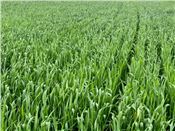Wheatlage Or Grain? New Decision Tool Helps Find The 'Sweet Spot'

Wheat before the boot stage.
COLUMBIA, MISSOURI
A new tool helps farmers decide the breakeven price for wheatlage compared to harvesting their wheat as grain.
The spreadsheet tool was developed by Ray Massey, University of Missouri Extension professor of agricultural economics. Massey says the tool looks at what the standing crop is expected to be worth as a grain – though both yield and price can differ from now until actual harvest time – and what costs might change if it is harvested as wheatlage. For example, changes could include no need for a combine but also potential higher fertilizer replacement costs.
Massey says the bottom line is, “If you can sell the wheat standing in the field for more than you can get for the grain minus harvest costs, you are better off harvesting as wheatlage rather than waiting to harvest as a grain.”
Reasons some growers are considering this:
• They expect lower-than-normal wheat yields and may want to harvest the whole plant.
• They have more need for forage than for wheat grain income.
• They want to harvest the wheat early and plant corn or soybean because those crops are expected to be so profitable this year.
“The dairy herd requires high-quality forages, which wheatlage can provide,” says MU Extension dairy specialist Reagan Bluel.
Bluel says the tool helps farmer neighbors who have different goals determine the “sweet spot” for pricing this high-quality feedstuff, so both benefit.
Dairy producers should keep a close eye on the stage of the wheat, she says. “Once beyond boot, when the head is barely showing, forage quality will dramatically change, quickly. If the wheatlage is put up too late, the forage will limit intake.”
The release of the tool comes at a time of historically low nationwide forage inventories.
“Depending on the fertilization of the farm, producers may be anticipating lower yields at home,” Bluel says. “Also, the late spring silage planting season, if extended much longer, will likely result in decreased tonnage. Producers are looking to fill a forage gap to feed their herd.”
A wrong decision this year will be more expensive because of high prices, says Joe Horner, MU Extension agricultural economist.
“Normally, livestock farmers struggle to value small-grain silage because forage quality and moisture content are hard to estimate, and they change daily,” Horner says. “This year’s jump in feed, fertilizer and fuel prices makes pricing wet forage even harder.”
Horner says the MU silage valuation tool removes guesswork.
“Good-quality wheat silage is going to be worth more than feeders think,” he says. “Wheat fields past prime silage quality will be worth more if left to harvest for grain. The time window between smart cutting for silage versus combining for grain will be determined by weather, and it will be short.”
Producers have two options to harvest wheat for silage, says Ryan Lock, MU Extension specialist in plant science. 1) The wheat can be direct cut with a silage chopper and hauled to an ensiling site, where it’s piled and packed to exclude oxygen. 2) It can be baled as high- moisture round-bale silage. If baled, it must be wrapped in plastic as individual bales or with an in-line wrapper to make long tubes of bales.
Lock says both methods take planning.
Download the tool at muext.us/WheatSilagePricing. ∆
JULIE HARKER: University of Missouri